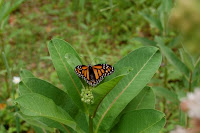

Bringing Nature Home: How Native Plants Sustain Wildlife in our Gardens
By Carolyn Summers
Continuing our review of Dr. Douglas Tallamy’s Bringing Nature Home, How Native Plants Sustain Wildlife in our Gardens, let’s see how this book answers the questions raised last week. Over thousands of years, plants evolved in the presence of insect predators; in self-defense, plants produced specific changes in leaf chemistry particular to each species. No two are exactly alike. The defenses are successful in reducing the number of predators to usually no more than a handful (sometimes only one) species for each species of plant. This is the origin of host specificity, a concept many butterfly gardeners are familiar with. Perhaps the most well-known example of butterfly-host plant relationships is the monarch, whose caterpillars can only survive on milkweed plants. The flip side of beneficial host plant-insect relationships is that exotic plants are safe from predation by our insects ("pest-free") by virtue of their unique leaf chemistry – great for the individual plant, great for the individual gardener – terrible for the world at large. Every exotic plant taking up space here is raiding the refrigerator. Although the exotic plant converts the sun’s energy through photosynthesis, that energy is unavailable to the rest of the ecosystem. At the point where exotics begin to make up a high percentage of our vegetation, insect populations will inevitably plunge.
The uninitiated may think that sounds fine, in the same way that warmer winters from global warming may sound fine to someone who dislikes snow. But those of us who love our gardens full of color in motion and bird songs will recognize that without an adequate supply of high-protein insect food, baby birds cannot fledge. And, of course, the food chain doesn’t end with birds. The good news is that we, as native plant gardeners, can turn things around. The chapter entitled "What Should I Plant?" provides practical guidance for gardeners of all levels. The following chapter, engagingly entitled, "What Does Bird Food Look Like?" is a mini-field guide to insects, many of which are outrageously beautiful, as shown in the excellent photographs.
To read the first installation of this article, scroll down to the post on Wednesday, March 25.
Visit Wednesday, April 8 for the final installation of the article.
I have a friend that might want to hire a Native Plant Expert - can you recommend someone? In Westchester.
ReplyDelete